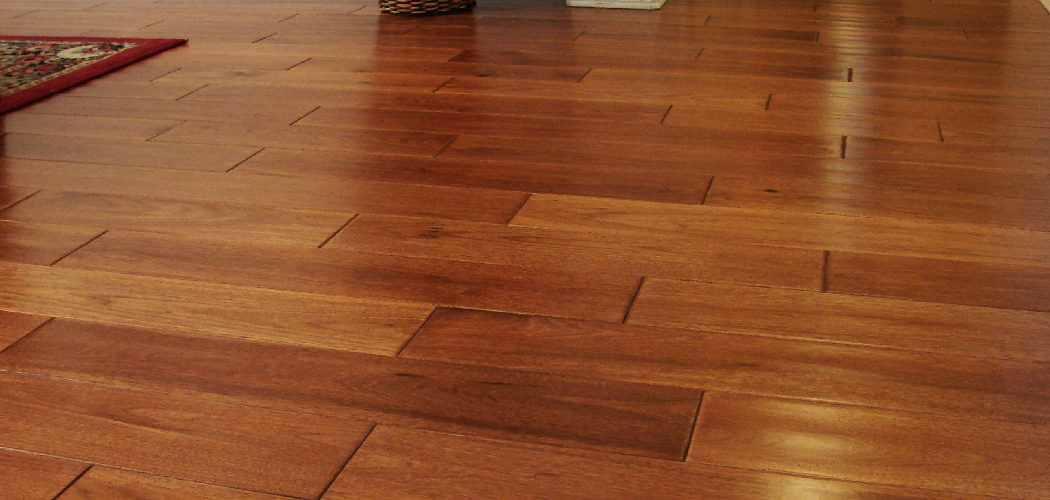Linoleum flooring is famous for rental properties due to its durability, affordability, and easy maintenance. However, if you prefer something other than the design or color of your linoleum flooring, you may wonder how to cover it up without damaging it.
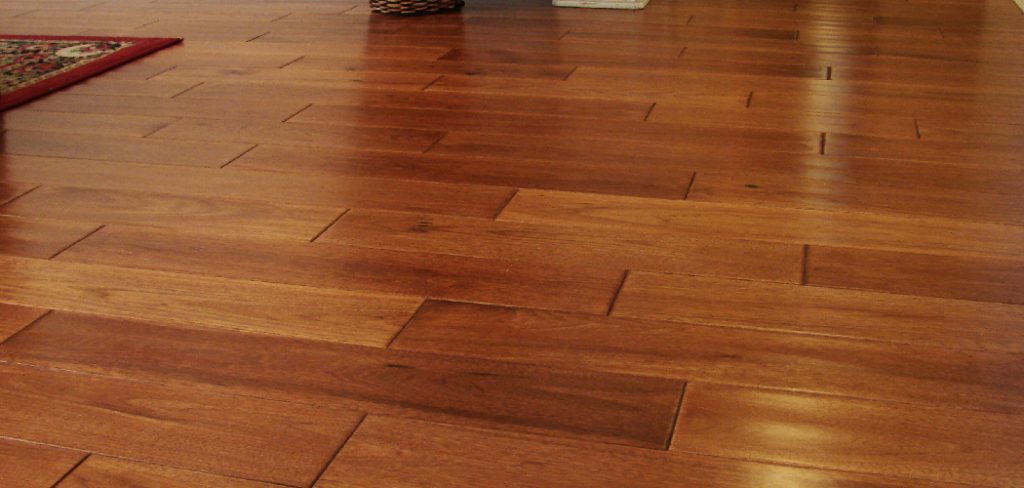
If you’re living in a rental property with linoleum flooring, you may be looking for ways to cover it up and make it your own. Whether you don’t like the look or feel of linoleum or simply want to add some personal style to your space, there are several options for covering linoleum floors without making permanent changes.
In this guide on how to cover linoleum flooring in a rental, we’ll discuss different ways to cover linoleum flooring in a rental property, including temporary and reversible options. We’ll also provide tips on how to choose the best choice for your space and budget.
Why Cover Linoleum Flooring?
There are many reasons why you may want to cover linoleum flooring in a rental property. For starters, linoleum is not the most visually appealing flooring option and may not fit with your personal style or design preferences. Additionally, linoleum can become worn and stained over time, making it look outdated and dirty.
Covering linoleum flooring can also help you make your rental property feel more like home by adding your own personal touch. Whether you choose to cover it with a rug, adhesive tiles, or vinyl plank flooring, these options can help transform a space and make it feel more like your own. Plus, covering linoleum can also provide added insulation and noise reduction.
If you’re renting a property with linoleum flooring, it’s essential to choose temporary options for covering it. This will allow you to remove the coverings easily when you move out without causing any permanent damage to the flooring underneath. Let’s take a look at some temporary and reversible options for covering linoleum flooring in a rental property.
Necessary Items
Before you cover your linoleum flooring, there are a few necessary items that you will need to gather. These include:
- Measuring Tape: This will come in handy when determining the amount of material needed for your chosen covering option.
- Covering Materials: Depending on your chosen option, you will need the appropriate covering materials, such as rugs, adhesive tiles, or vinyl planks.
- Scissors: These will be needed for cutting and trimming the covering materials to fit your space.
- Double-sided Tape: This can help secure your temporary covering in place without damaging the linoleum underneath.
- Plywood Sheets (optional): If you plan on using adhesive tiles or vinyl planks, you may need plywood sheets to create a smooth and level surface to adhere to the covering materials.
- Cleaning Supplies: It’s essential to thoroughly clean your linoleum flooring before covering it to ensure a smooth and even surface for your coverings.
Temporary Options for Covering Linoleum Flooring
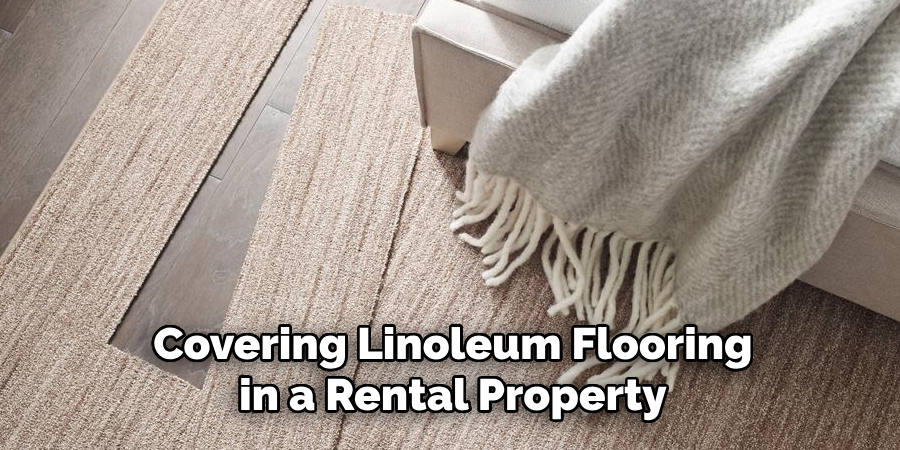
As mentioned before, choosing temporary options for covering linoleum flooring in a rental property is essential. Here are a few options that are easy to install and remove without causing any damage:
1) Rugs
One of the easiest and most affordable ways to cover linoleum flooring is by using rugs. Not only do carpets come in a wide variety of styles, colors, and patterns, but they can also be easily removed when you move out. You can choose one large rug to cover the majority of the flooring or multiple smaller rugs to add some design and texture to your space.
2) Adhesive Tiles
Another temporary option for covering linoleum flooring is by using adhesive tiles. These are a great choice if you want a more permanent-looking solution without causing any damage to the linoleum underneath. Adhesive tiles come in a variety of styles and can be easily removed without leaving any residue behind.
3) Vinyl Plank Flooring
Similar to adhesive tiles, vinyl plank flooring is another temporary and non-damaging option for covering linoleum floors. These are easy to install and can provide a more realistic wood or tile look to your space. They are also waterproof, durable, and budget-friendly.
8 Things to Know Before You Start
1. Check With Your Landlord
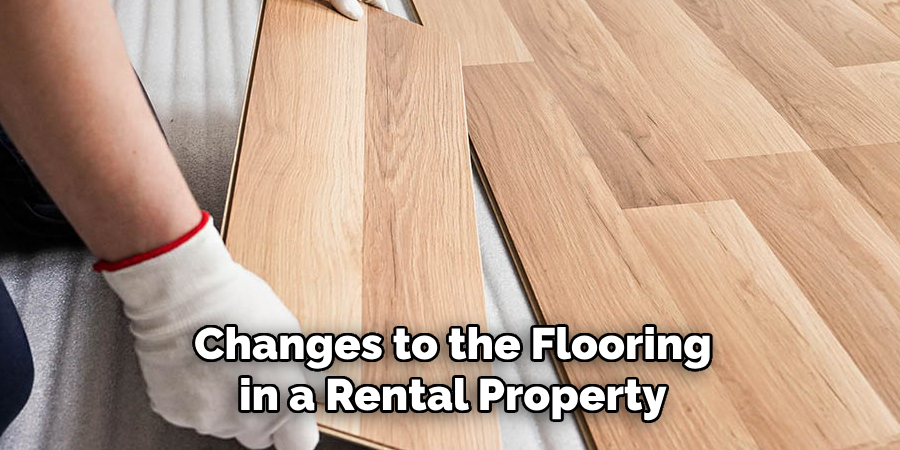
Before making any changes to the flooring in a rental property, it’s essential to check with your landlord first. Ensure you have their permission and discuss what options are acceptable for covering linoleum. It’s also a good idea to have a written agreement in place stating that you will return the flooring to its original state before moving out.
2. Know Your Budget
Covering linoleum floors can range from affordable options like rugs and adhesive tiles to more expensive options like vinyl plank flooring. Knowing your budget beforehand can help you narrow down your options and choose the best covering for your needs.
3. Consider the Duration
Before deciding on a cover, think about how long you plan on staying in your rental property. If it’s a short-term living situation, temporary options like rugs or adhesive tiles may be more suitable. For more extended stays, more permanent options like vinyl plank flooring may be worth the investment.
4. Evaluate the Condition of the Linoleum
If your linoleum flooring is in good condition, you may be able to simply cover it with a rug or adhesive tiles without any additional preparation. However, if it’s worn or damaged, you may need to clean and repair it before covering it up.
5. Measure Your Space
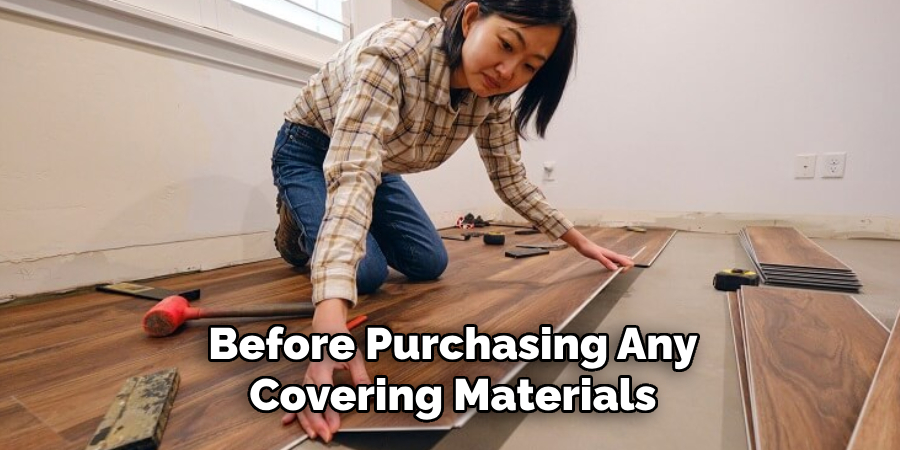
Before purchasing any covering materials, make sure to accurately measure your space to determine how much you will need. This can help you avoid purchasing too little or too much, saving you time and money.
6. Plan for Trimming
Many covering options may require trimming to fit perfectly in your space. Make sure to have the necessary tools on hand and allow for extra material in case of mistakes. If you’re not comfortable with trimming, consider opting for a covering option that doesn’t require it.
7. Clean and Prepare the Flooring
Thoroughly cleaning your linoleum flooring before covering it is crucial for ensuring a smooth and even surface. Use a mild cleaning solution and let it dry completely before proceeding with the coverings.
8. Test in a Small Area First
If you’re using adhesive tiles or vinyl plank flooring, it’s important to test them in a small area first before fully committing. This will allow you to see how they adhere to the linoleum and make any necessary adjustments before covering the entire floor.
Covering linoleum flooring in a rental property is an easy way to give your space a fresh look without making permanent changes. With suitable materials and preparation, you can transform your linoleum floors and make them feel like home. Just remember to always check with your landlord first and have a plan in place for returning the flooring to its original state before moving out. So, be creative and have fun decorating your space with these temporary covering options!
10 Steps on How to Cover Linoleum Flooring in a Rental Property
Step 1: Measure Your Space and Determine the Amount of Covering Materials Needed
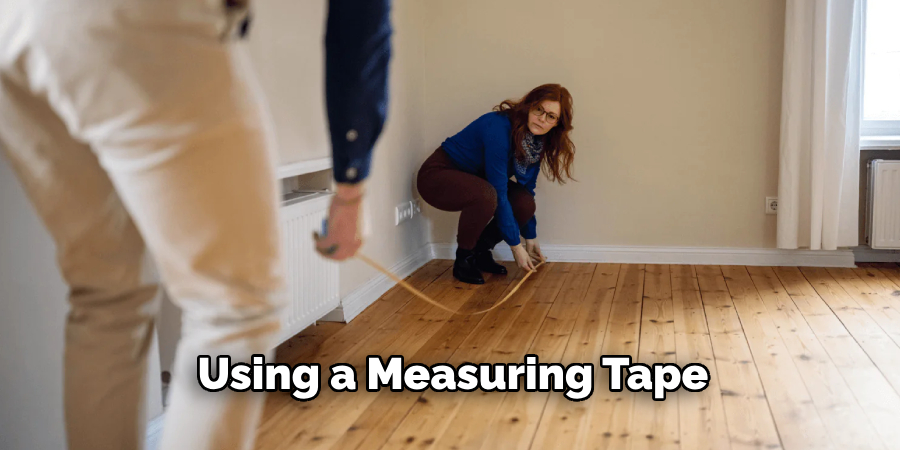
Using a measuring tape, measure the length and width of your space to determine how much covering material you will need. It’s always a good idea to purchase extra fabric in case of mistakes.
Step 2: Choose Your Covering Option
Consider your budget, duration of stay, and personal style when choosing a covering option for your linoleum flooring. Some popular options include rugs, adhesive tiles, and vinyl plank flooring.
Step 3: Gather Necessary Materials
Make sure you have all the necessary materials on hand before starting the covering process. This may include measuring tape, covering materials, scissors, double-sided tape, plywood sheets (if using adhesive tiles or vinyl planks), and cleaning supplies.
Step 4: Clean and Prepare the Flooring
Thoroughly clean your linoleum flooring using a mild cleaning solution. Make sure to let it dry completely before proceeding with the coverings. And, if necessary, repair any worn or damaged areas.
Step 5: Lay Down the Covering Materials
Following the instructions for your chosen covering option lay down the materials on top of the linoleum flooring. For adhesive tiles and vinyl planks, make sure to follow the recommended pattern and direction for installation.
Step 6: Trim as Needed
If your covering materials require trimming, use scissors to carefully cut and trim them to fit perfectly in your space. Make sure to leave some extra fabric in case of mistakes. While trimming, follow the recommended pattern and direction for installation.
Step 7: Secure with Double-Sided Tape (Optional)
If using a temporary covering option like rugs, you may secure them in place with double-sided tape. This will help prevent them from moving or slipping on the linoleum flooring.
Step 8: Use Plywood Sheets (Optional)
For adhesive tiles or vinyl planks, it’s recommended to use plywood sheets as a base for better adhesion. Cut the sheets to fit your space and lay them down on top of the linoleum flooring before installing the covering materials.
Step 9: Test in a Small Area (Optional)
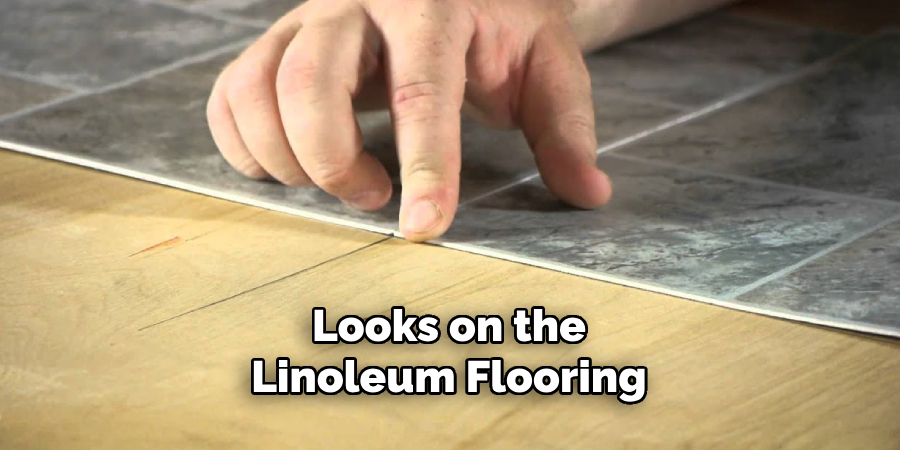
Before fully committing to a covering option, test it in a small area first to see how it adheres and looks on the linoleum flooring. This will allow you to make any necessary adjustments before covering the entire floor.
Step 10: Have a Written Agreement with Your Landlord
Before making any changes to your rental property, always check with your landlord and have a written agreement in place stating that you will return the flooring to its original state before moving out. This will prevent any potential conflicts or issues in the future.
By following these ten steps on how to cover linoleum flooring in a rental, you can easily cover your linoleum flooring in a rental property and make it feel more like home. Remember always to take proper precautions and check with your landlord before making any changes.
And most importantly, have fun decorating and personalizing your space with these temporary covering options. So, go forth and make your rental property feel more like a home!
8 Things to Avoid When Covering Linoleum Flooring in a Rental Property
While covering your linoleum flooring can be a simple and cost-effective way to transform your rental space, there are some things you should avoid in the process to ensure a smooth and hassle-free experience. Here are eight things to avoid when covering linoleum flooring in a rental property:
1. Using Permanent Coverings
As a renter, you want to avoid making permanent changes to the property. This includes using coverings that require adhesive or nails to adhere to the linoleum flooring. Stick to temporary covering options like rugs, adhesive tiles, and vinyl planks.
2. Neglecting to Check with Your Landlord
Before making any changes to your rental property, always check with your landlord first. They may have specific regulations or restrictions on what can and cannot be done to the flooring.
3. Not Having a Plan for Returning the Flooring to its Original State
Before moving in, have a plan in place for returning the flooring to its original state when you move out. This may include keeping extra covering materials, using removable adhesives, or hiring a professional to remove any temporary coverings.
4. Using Covering Materials That are Too Heavy
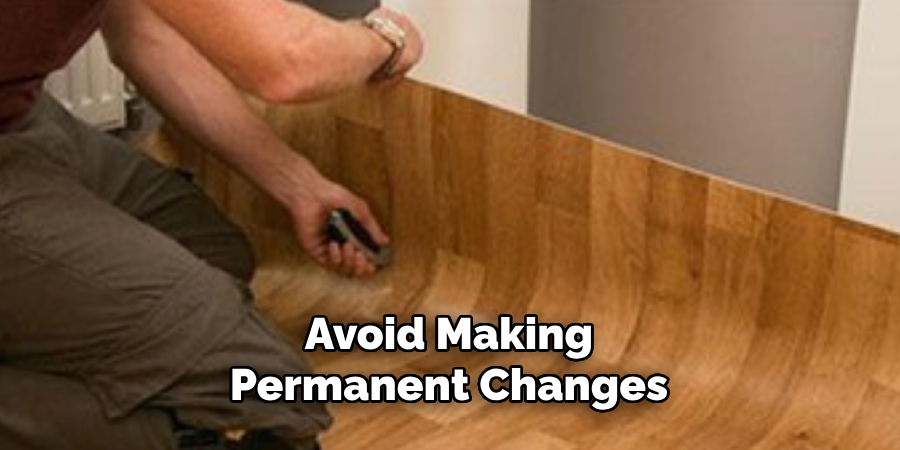
Avoid using covering materials that are too heavy for linoleum flooring. This can cause damage and make it difficult to return the flooring to its original state when you move out. So, stick to lightweight options like rugs or vinyl planks.
5. Rushing the Cleaning and Preparation Process
Properly cleaning and preparing your linoleum flooring is crucial for ensuring a smooth covering process. Take your time and make sure the floor is arid before proceeding with coverings. While cleaning, also make sure to repair any damaged areas.
6. Not Testing Coverings in a Small Area First
Before covering the entire floor, it’s always a good idea to test your chosen coverings in a small area first. This will allow you to make any necessary adjustments and ensure the materials adhere correctly before committing to covering the entire space.
7. Not Considering Your Budget and Personal Style
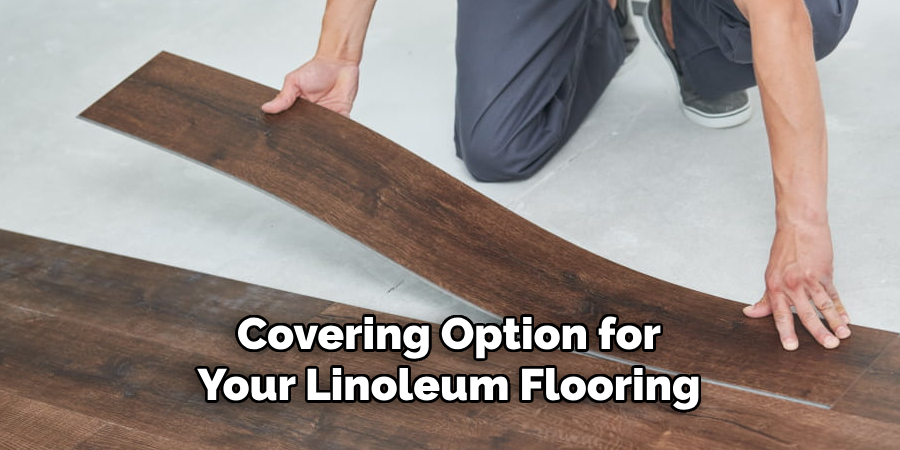
When choosing a covering option for your linoleum flooring, make sure to consider your budget and personal style. Don’t overspend on coverings that may not match your decor or break the bank.
8. Failing to Secure Coverings Properly
If you choose to use temporary coverings like rugs, make sure to secure them properly with double-sided tape. This will prevent them from slipping or moving on the linoleum flooring, potentially causing accidents or damage.
By avoiding these eight things on how to cover linoleum flooring in a rental, you can ensure a successful and stress-free experience when covering your linoleum flooring in a rental property. Remember to always check with your landlord and prioritize temporary coverings that can easily be removed and won’t cause damage to the flooring.
Now, transform your rental space into a cozy and personalized home! So, have fun decorating and personalizing your space with these temporary covering options. With the right planning and precautions, you can easily cover your linoleum flooring in a rental property without any issues or conflicts.
Frequently Asked Questions About Covering Linoleum Flooring in a Rental Property
Here are some commonly asked questions about covering linoleum flooring in a rental property:
Can I Use Adhesive Tiles on Linoleum Flooring?
Yes, you can use adhesive tiles on linoleum flooring. However, it’s recommended to use plywood sheets as a base for better adhesion. Cut the sheets to fit your space and lay them down on top of the linoleum flooring before installing the adhesive tiles.
Is it Okay to Use Rugs on Linoleum Flooring?
Yes, you can use rugs on linoleum flooring. However, it’s recommended to secure them in place with double-sided tape to prevent slipping or moving. Also, avoid using mats that are too heavy, as this can cause damage to the flooring.
Can I Paint Linoleum Flooring?
Yes, you can paint linoleum flooring to give it a new look. However, be sure to thoroughly clean and prime the floor before painting and use special epoxy or latex paints designed for linoleum floors.
How Do I Remove Coverings from Linoleum Flooring?
To remove temporary coverings from linoleum flooring, simply peel or lift them off carefully. If there is any residue left behind, use a mild cleaner to remove it. For adhesive tiles or vinyl planks, a heat gun or hairdryer can help loosen the adhesive for easier removal.
Can I Cover the Linoleum Flooring With Carpet?
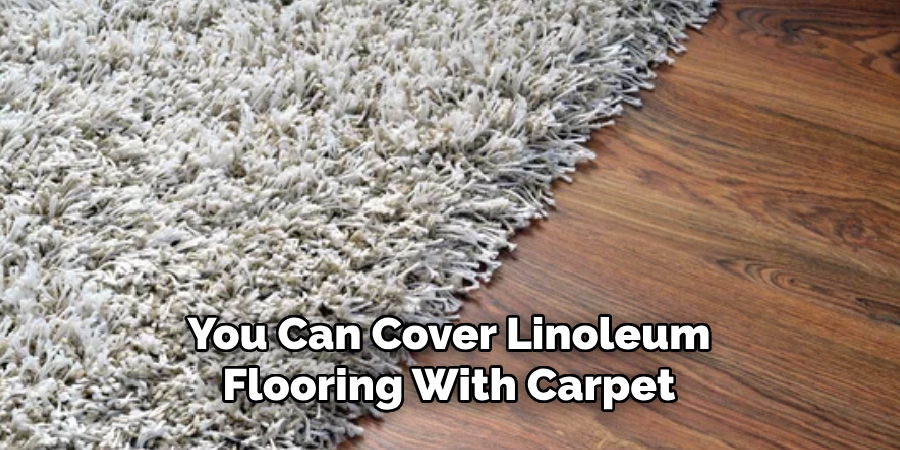
Yes, you can cover linoleum flooring with carpet. However, it’s essential to use a non-slip pad underneath the carpet to prevent it from moving or slipping on the smooth surface of the linoleum flooring. It’s also recommended to secure the edges of the rug with double-sided tape for added stability.
So, with these FAQs answered, you’re now equipped with the knowledge and tips to cover your linoleum flooring effectively in a rental property. Remember always to prioritize temporary options that can easily be removed without causing damage, and check with your landlord before making any changes to the property.
Conclusion
Covering linoleum flooring in a rental property doesn’t have to be a daunting task. By avoiding permanent coverings, checking with your landlord, and having a plan for returning the flooring to its original state, you can transform your space without any issues. Take your time when cleaning and preparing the floor and test coverings before committing to them, and consider your budget and personal style.
And remember to secure temporary surfaces for safety and stability properly. With these tips on how to cover linoleum flooring in a rental in mind, you can easily personalize your rental space while still respecting your landlord’s property. So, go ahead and get creative with your temporary covering options to make your rental feel like home!
